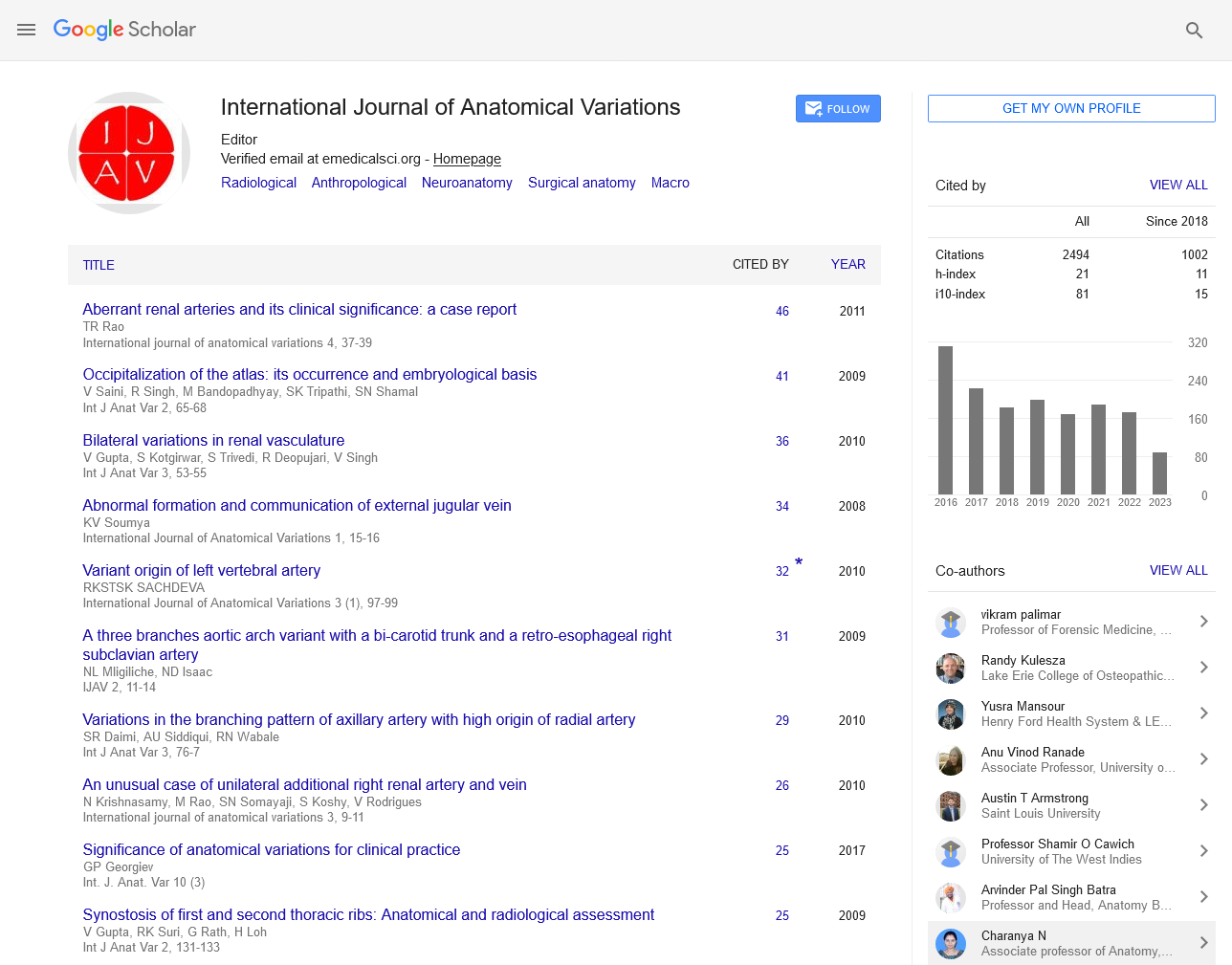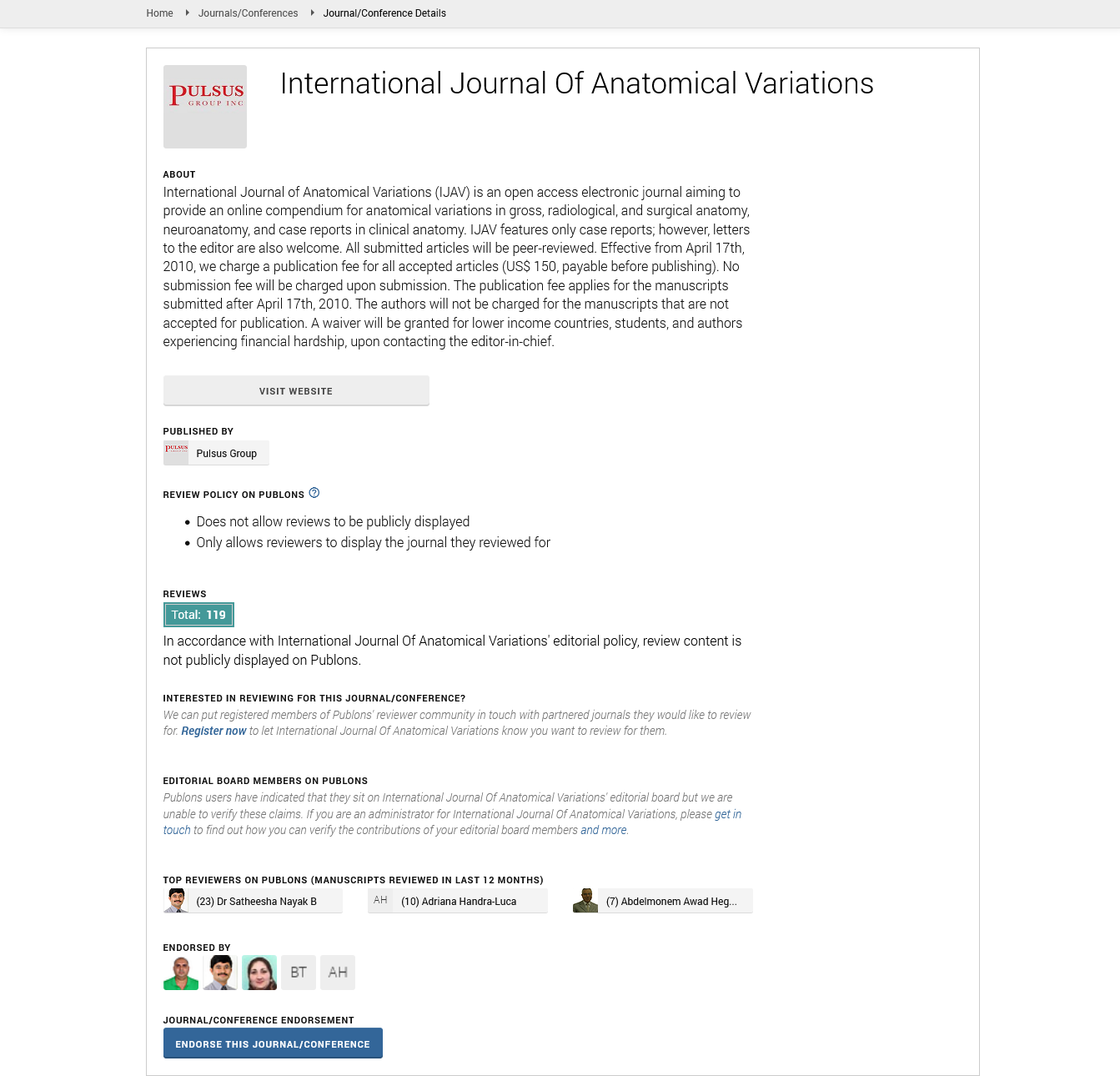Variations in the Musculoskeletal System Impact on Orthopedic Interventions for Congenital Limb Anomalies
Received: 02-Dec-2024, Manuscript No. ijav-24-7362; Editor assigned: 04-Dec-2024, Pre QC No. ijav-24-7362 (PQ); Reviewed: 18-Dec-2024 QC No. ijav-24-7362; Revised: 26-Dec-2024, Manuscript No. ijav-24-7362 (R); Published: 31-Dec-2024, DOI: 10.37532/1308-4038.17(12).469
Citation: Kusunoki Y. Variations in the Musculoskeletal System Impact on Orthopedic Interventions for Congenital Limb Anomalies. Int J Anat Var.2024;17(12): 707-708.
This open-access article is distributed under the terms of the Creative Commons Attribution Non-Commercial License (CC BY-NC) (http://creativecommons.org/licenses/by-nc/4.0/), which permits reuse, distribution and reproduction of the article, provided that the original work is properly cited and the reuse is restricted to noncommercial purposes. For commercial reuse, contact reprints@pulsus.com
Abstract
Congenital limb anomalies, which involve malformations of the bones, muscles, joints, and soft tissues, present significant challenges for orthopedic interventions. These anomalies can range from limb deficiencies, such as amelia and phocomelia, to deformities like clubfoot, polydactyly, and syndactyly, each requiring tailored surgical approaches. Variations in musculoskeletal structures, including bone length, joint alignment, tendon attachment, and soft tissue integrity, complicate surgical planning and execution. For example, limb deficiencies may necessitate bone grafting or prosthetic interventions, while conditions like clubfoot require precise tendon lengthening or joint releases. In cases of syndactyly, tendon transfers and skin grafts may be needed for functional reconstruction. Early diagnosis and advanced imaging techniques are crucial for creating individualized treatment plans that address both functional and aesthetic concerns. Understanding these musculoskeletal variations is vital for orthopedic surgeons to optimize surgical outcomes and improve the quality of life for individuals with congenital limb anomalies
Keywords
Musculoskeletal system; Congenital limb anomalies; Orthopedic interventions; Limb deformities; Orthopedic surgery; Congenital limb abnormalities; Limb reconstruction; Musculoskeletal variations
INTRODUCTION
The congenital limb anomalies represent a diverse group of conditions that can affect the development of the musculoskeletal system, including bones, muscles, joints, and soft tissues. These anomalies may manifest as missing, underdeveloped, or abnormally shaped structures, and their impact can range from mild functional limitations to severe disability. The musculoskeletal system, which forms the foundation for movement and physical function, is often the site of these congenital variations, and they present unique challenges for orthopedic surgeons. Orthopedic interventions aimed at correcting or managing these anomalies must consider the anatomical variations that may affect surgical planning, technique, and outcomes. This article explores the types of musculoskeletal variations found in congenital limb anomalies and their implications for orthopedic interventions [1].
OVERVIEW OF CONGENITAL LIMB ANOMALIES
Congenital limb anomalies are disorders that arise during fetal development, leading to malformations of the limbs. These conditions may involve the upper limbs, lower limbs, or both, and can range from mild deformities that cause little functional impairment to severe cases requiring extensive surgical intervention. Congenital limb anomalies can be classified into several categories; including Orthopedic surgeons must evaluate the underlying anatomical structures, assess the functional potential of the limb, and determine the best approach for intervention. Musculoskeletal variations in these anomalies can present additional challenges during surgical correction or reconstruction [2].
TYPES OF MUSCULOSKELETAL VARIATIONS IN CONGENITAL LIMB ANOMALIES
Limb Deficiencies
Limb deficiencies refer to the congenital absence of part or all of a limb. These deficiencies may be classified as amelia (complete absence of a limb), phocomelia (shortened limbs with absent or underdeveloped segments), or micromelia (generalized shortening of the limbs). The severity of the deficiency can vary greatly, and musculoskeletal variations in these conditions can lead to complex surgical management [3]. In cases of phocomelia, the absence of a portion of the limb or abnormal positioning of the remaining segment can require bone grafting, limb-lengthening procedures, or prosthetic interventions. Variations in the shape and development of the bones and joints complicate the reconstruction process, as the skeletal structure may not align properly, requiring customized surgical approaches.
Clubfoot (Talipes Equinovarus)
Clubfoot is a common congenital deformity of the foot characterized by plantar flexion, inversion, and adduction of the foot. The condition can involve varying degrees of severity and often presents with musculoskeletal variations such as shortened tendons, abnormal joint formation, and tightness in the soft tissues. Orthopedic interventions for clubfoot may include conservative methods such as the Ponseti method, which involves manipulation and casting, or surgical interventions in more severe cases. Musculoskeletal variations, such as abnormal positioning of the talus and tibia, affect the surgical technique. For instance, if the talus is excessively tilted or the ankle joint is unusually rigid, more extensive procedures, such as tendon lengthening, joint releases, or even bone fusions, may be required to restore normal alignment and function [4].
Polydactyly and Syndactyly
Polydactyly is a condition characterized by the presence of extra fingers or toes, while syndactyly refers to the fusion of two or more digits. These congenital abnormalities can range from mild cases, where the extra digit is fully functional, to more severe forms requiring surgical intervention. Polydactyly can involve variations in the bones, joints, muscles, and tendons of the hand or foot, making the correction process more complex.
Syndactyly, often resulting from incomplete separation of the digits during fetal development, may require surgical release and reconstruction to restore normal hand or foot function. The degree of fusion and the number of affected digits will determine the surgical approach [5]. Variations in tendon attachments or abnormal bony formations may require additional procedures to ensure proper functionality and aesthetic appearance.
Congenital Hip Dislocation (Developmental Dysplasia of the Hip)
Developmental dysplasia of the hip (DDH) is a condition in which the hip joint is abnormally formed, leading to dislocation or subluxation. This condition is common in infants and can lead to long-term functional impairment if not corrected early. The condition involves variations in the acetabulum, femoral head, and ligaments of the hip joint. Early intervention is crucial for preventing permanent damage to the hip joint and ensuring normal walking and development. Treatment typically involves the use of a Pavlik harness for mild cases or surgical procedures such as hip reduction, acetabular reshaping, or femoral head reconstruction for more severe cases. Musculoskeletal variations in the joint, such as underdeveloped acetabulum or a shallow hip socket, may require bone grafting or additional joint stabilization procedures [6].
Radial and Ulnar Dysplasia
Radial and ulnar dysplasia is congenital abnormalities of the forearm where the radius or ulna bone is underdeveloped or absent. This condition can result in functional limitations of the arm, including restricted movement of the elbow, wrist, or hand. The severity of radial or ulnar dysplasia can vary widely, ranging from minor underdevelopment to complete absence of the bones. Orthopedic intervention depends on the degree of the dysplasia and the presence of associated musculoskeletal variations. In some cases, limb-lengthening or reconstructive surgeries, such as radial head replacement or elbow joint fusion, may be required. Variations in bone length, joint stability, and soft tissue integrity will guide surgical planning and the choice of prosthetic or reconstructive techniques [7].
IMPACT OF MUSCULOSKELETAL VARIATIONS ON ORTHOPEDIC INTERVENTIONS
Surgical Planning and Customization
Orthopedic interventions for congenital limb anomalies often require careful preoperative planning to account for anatomical variations. These variations can affect the alignment of bones and joints, tendon lengths, and the distribution of muscle forces. Preoperative imaging, such as X-rays, CT scans, and MRIs, is essential to understand the extent of the musculoskeletal abnormalities and plan the most effective surgical approach.
For example, in cases of limb deficiencies or clubfoot, variations in the size and shape of bones may necessitate the use of custom prosthetics or orthoses. In cases of polydactyly or syndactyly, the surgeon must account for the number of affected digits, the integrity of tendons, and the function of the joints before planning reconstructive procedures [8].
Bone Reconstruction and Limb-Lengthening Procedures
In congenital limb anomalies where bone development is incomplete or abnormal, bone reconstruction or limb-lengthening procedures may be necessary. Musculoskeletal variations in the form of short bones, absent segments, or abnormal joint formation can complicate these procedures. Surgeons may need to employ techniques such as distraction osteogenesis (using external fixation devices to gradually lengthen bones) or bone grafting to achieve functional limb length. In cases of radial or ulnar dysplasia, bone grafts or prosthetic replacements may be used to replace the missing bone structure. Customized surgical techniques will be employed based on the patientâ??s individual anatomy to optimize limb function and appearance.
Soft Tissue and Tendon Management
In many cases of congenital limb anomalies, the soft tissuesâ??such as muscles, tendons, and ligamentsâ??are also affected. Variations in the size, attachment points, or function of these soft tissues can further complicate orthopedic interventions. For example, in clubfoot, the Achilles tendon may be shortened, and the muscles around the ankle may be tight or contracted, requiring tendon lengthening or muscle releases during surgery.
Similarly, in cases of syndactyly, soft tissue management is crucial to ensure that the separated digits maintain adequate functionality and skin coverage [9]. Tendon transfers, skin grafts, and scar management may be necessary to achieve the desired result.
CLINICAL IMPLICATIONS FOR ENDOSCOPIC PROCEDURES
Endoscopic Diagnosis and Treatment
Endoscopic procedures, including flexible esophagoscopy and endoscopic retrograde cholangiopancreatography (ERCP), play a critical role in diagnosing and treating esophageal conditions. Unusual anatomical variations, such as diverticula or vascular malformations, can obstruct the view, making it challenging to accurately diagnose or treat the condition. Endoscopists must be vigilant in recognizing variations and taking extra care to avoid complications such as perforation.
Management of Esophageal Varices
Endoscopic interventions for esophageal varices, such as banding or sclerotherapy, can be life-saving in patients with portal hypertension. However, the presence of other vascular anomalies may increase the complexity of the procedure. Special care must be taken to avoid damaging normal vessels while targeting the varices for treatment [10].
CONCLUSION
Congenital limb anomalies represent a diverse and complex group of conditions that often require orthopedic intervention to improve function and quality of life. Variations in the musculoskeletal system, whether involving bone, joints, muscles, or soft tissues, play a significant role in determining the appropriate surgical approach. Understanding these variations is essential for orthopedic surgeons to plan and execute interventions effectively. With advances in imaging and surgical techniques, surgeons are better equipped to manage the complexities of congenital limb anomalies and deliver tailored, patient-specific care that addresses both the functional and aesthetic needs of the patient. As research continues, the development of more precise surgical methods and prosthetic devices promises to improve outcomes for individuals with congenital limb anomalies.
REFERENCES
- Janda P, Pękala J, Malinowski K. The subscapularis muscle‐a meta‐analysis of its variations, prevalence, and anatomy. Clin Anat. 2023; 36(3):527-541.
- Pivin EA, Krakhmaleva DA. Mechanisms of corneal neovascularization and modern options for its suppression. Vestn Oftalmo. 2016; 132(4):81-87.
- Christian J. Commentary: Thoracic surgery residency: Not a spectator sport. J Thorac Cardiovasc Surg. 2020 Jun; 159(6):2345-2346.
- Shigeru H. Glomerular Neovascularization in Nondiabetic Renal Allograft Is Associated with Calcineurin Inhibitor Toxicity. Nephron. 2020; 144 Suppl 1:37-42.
- Konschake M, Olewnik Ł. Unknown variant of the accessory subscapularis muscle?. Anat Sci Int. 97(1), 138-142.
- Youdas JW. Bilateral presence of a variant subscapularis muscle. Int J Anat Var. 2017; 10(4):79-80.
- Kameda Y. An anomalous muscle (accessory subscapularis teres latissimus muscle) in the axilla penetrating the brachial plexus in man. Acta Anat. 1976; 96:513-533.
- Podgórski M, Karauda P, Polguj M. The subscapularis tendon: a proposed classification system. Ann Anat. 2021; 233:151-615.
- Teixeira AR, Leite TFO, Babinski MA. Accessory subscapularis muscle–A forgotten variation?. Morphologie. 2017; 101(333):101-104.
- Jacob SM. Bilateral presence of axillary arch muscle passing through the posterior cord of the brachial plexus. Int. J. Morphol., 27(4):1047-1050, 2009.
Indexed at, Google Scholar, Crossref
Indexed at, Google Scholar, Crossref
Indexed at, Google Scholar, Crossref
Indexed at, Google Scholar, Crossref
Indexed at, Google Scholar, Crossref
Indexed at, Google Scholar, Crossref
Indexed at, Google Scholar, Crossref
Indexed at, Google Scholar, Crossref






